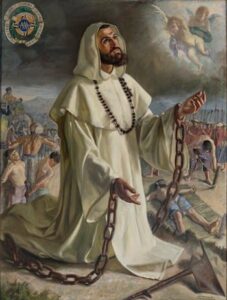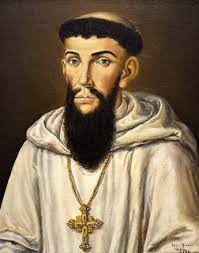dominican saints
Bl. Jose Diaz Sanjurjo, Bl. Melchoir Garcia Sampedro & Companions, M.M.O.P.
Feast Day July 27th

bl. melchoir garcia sampredo, B.M.O.P.

bl. Jose Diaz Sanjurjo, B.M.O.P.
“I am going to Heaven. I take pity on you who must remain” (last words of Bishop Sanjurjo).
The group of Dominican martyrs beatified in 1952 is made up of Dominicans of the First and Third Orders who died in 1857 and 1858. There were two bishops, Jose Diaz Sanjurjo and Melchior Garcia Sampedro; two Dominican priests of the Fist Order, two Dominican Tertiary priests, and nineteen lay members of either the Third Order or the Confraternity, of whom seven were fathers of families,
Jose Sanjurjo was born in Lugo in Spain in 1818. Being a promising student with literary talents, he was marked for a career in the world, and his parents were not too happy about his decision to be a Dominican. Because if their opposition he stole away from home by night and entered the Dominican novitiate at Ocaña, the training ground for missionaries for the Philippines and the Far East.
Melchior Sampedro was born at Cortes in Asturias in 1821. He was a prayerful, serious boy, contemplative by nature and especially fond of the Rosary. Since his parents were too poor to provide him with an education, he set about working his way through college by teaching grammar to younger students. His parents looked forward hopefully to the time when he would raise them from poverty. It was consequently a sacrifice when he left for the Dominican novitiate at the age of twenty-four. The two future missionary martyrs were trained in the same school of sanctity. They were not to meet, however, until they reached the Philippines.
Father Sanjurjo went to Cadiz on making his vows and sailed for Manila, a 120 day voyage. Each day on board the ship he led the Rosary with the passengers. He arrived at Manila on the Feast of the Holy Cross and was assigned to teach at the University of Santo Tomás for six months until he be assigned to the missions. Father Sampedro arrived in July and begged for immediate assignment.
Only the best and staunchest missionaries were sent to Tonkin becat of the desperate dangers on every hand. Even the way there was perilous. though the perils of crossing the ocean were not enough, they had to run risk of being killed by the soldiers of the emperor of Tonkin, who wate the ports. ‘The missionaries could only enter the forbidden kingdom native dress-a short native tunic, loose fitting trousers, and turbans. I this was not a good disguise, for most Europeans were much taller than the natives and had heavy beards. They must travel by night, fleeing through woods and swamps, going without food, sometimes hiding for days in a boat half under water, the prey of insects, fever, and exhaustion. Nevertheless, the Dominicans who voluntarily took on this difficult m fasted and abstained and kept the rule in its entirety.
Into this desperate life the two young Spaniards fitted themselves enthusiasm, Their companions fell exhausted trying to keep pace. Father Sampedro writes:
“Drenched from head to foot, covered with mud; with neither coat nor clothes for change, we deemed ourselves happy, do much, that the Vicar Apostolic and Vicar Provincial of the Eastern Province could sing in a poor hut, with the greatest joy, and I forgot the pains of my feet to praise the Lord. I have no fear of exaggeration in saying that randy we have greater joy than during the strongest tribulations.”
Shortly after they arrived in Tonkin, the Holy See divided the territory into two vicariates and Father Sanjurjo was appointed vicar of the central one. Father Sampedro was appointed coadjutor with right of succession. Their predecessor had been martyred a short time before. The appointment of the two new bishops came just in time to meet the full fury of the new persecution.
In spite of their care and disguise, the two Europeans were hard to hide in a land of little men who spoke another tongue. The Christians guarded them carefully, but one of the soldiers traced Father Sanjurjo and caught him in a surprise raid. He was taken to prison for two months, where his great charity did much to preach the meekness of Christ among the people who saw him bearing no grudge against the man who had betrayed him. On July 20, 1857, he was led out to execution. Chained heavily, he was marched in a long procession bright with pageantry and loud with oriental music. The emperor’s elephants dressed in glittering trappings, and the banners of the various military groups, gave vivid color to an occasion of terrible torture for the foreigner who had dared to invade the ancient kingdom. Bishop Sanjurjo was beheaded, and his body thrown into the sea.
Bishop Sempedro was undaunted by the fate of his companion, though he realized that his own would be the same. He even wanted to come out of hiding and make a public proclamation to prove that the priests were not afraid but was dissuaded by the Christians who pointed out that his time would come soon enough anyway, and in the meantime, they needed him. It was only a short time until a trap was laid for him and he was ambushed and captured. He was put into a small cage, a particularly terrible torture, and, along with two native laybrothers, taken to the same prison where his predecessor had been.
Almost a year to the day after Bishop Sanjurjo died, Bishop Sampedro was led out to execution and taken along his route to Calvary, pelted by mud and stones. Finally, he was laid on the ground and stretched out like the figure on the cross which the mandarin hated, and hacked to pieces bit by bilk His only response was to repeat the Holy Name until death claimed him The laybrothers were tortured and beheaded at the same time. After their death, their remains were thrown into a ditch, and the king’s elephants were led to trample over them. The beasts knelt down and refused to step on the spot where the martyrs lay. Eventually some of the relics of both of the bishops were recovered and treasured by the Christians.
Beatified in the same group with the two bishops are twenty-three others of every state in life. They died at different times and places, but since all were connected in some way with the Order, they have been grouped together. There were four priests, all natives. Father Dominic Mau and Father Joseph Tuan, who was far advanced in years, were priests of the First Order. Father Dominic Cam and Father Thomas Khuong, the son of a mandarin, were Tertiary priests. All died gloriously after long tortures. The laymen, members of the Confraternity, included men of all social classes. One was the wealthy Dominic An-Kham, who at the age of eighty was the prior of the Confraternity. He died with his son and several other wealthy members of the Confraternity who were killed for protecting missionaries. There were also two poor fishermen and two farmers who had been asked trample on the cross and refused to do so. A doctor, a judge, a tax collector, and several independent farmers, of whom most were the fathers of families, all gave up their lives joyfully in the cause of Christ. (Dorcy).